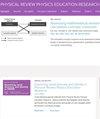Applying module analysis to the Brief Electricity and Magnetism Assessment
IF 2.6
2区 教育学
Q1 EDUCATION & EDUCATIONAL RESEARCH
Physical Review Physics Education Research
Pub Date : 2024-02-06
DOI:10.1103/physrevphyseducres.20.010104
引用次数: 0
Abstract
The Brief Electricity and Magnetism Assessment (BEMA) is a multiple-choice instrument commonly used to measure introductory undergraduate students’ conceptual understanding of electricity and magnetism. This study used a network analysis technique called modified module analysis-partial (MMA-P) to identify clusters of correlated responses, also known as communities, within 12214 BEMA responses. MMA-P identifies both communities related to the structure of the instrument and communities related to incorrect student reasoning. Every community resulting from MMA-P came from blocked items; groups of items that all refer to the same physical system. The most prevalent and consistently selected incorrect answers involved the relation of the electric field to the electric potential difference. The community structure identified in the Conceptual Survey of Electricity and Magnetism (CSEM) by a prior MMA-P study on items shared by the CSEM and BEMA differed because of the different incorrect responses available in the two instruments. One pair of items in the BEMA involving the induced electric field by a changing magnetic field showed evidence of students applying a variety of incorrect models; the scores on these items indicate their inclusion in the instrument should be reconsidered.

将模块分析应用于 "电与磁 "简要评估
简要电学和磁学评估(BEMA)是一种多选题工具,通常用于测量本科入门学生对电学和磁学概念的理解。本研究使用了一种名为 "修正模块分析-部分"(MMA-P)的网络分析技术,在 12214 个 BEMA 答案中识别出相关答案群,也称为群落。MMA-P 既能识别与测验结构相关的群落,也能识别与学生错误推理相关的群落。MMA-P 所产生的每一个群落都来自阻塞性项目;这些项目组均涉及相同的物理系统。最普遍和最常见的错误答案涉及电场与电势差的关系。在电学和磁学概念调查(CSEM)中,先前的 MMA-P 研究对 CSEM 和 BEMA 中的共同项目所确定的群体结构有所不同,因为这两种工具中的错误答案各不相同。在 BEMA 中,有一对项目涉及变化的磁场对电场的感应,结果表明学生应用了各种不正确的模型;这些项目的得分表明,应重新考虑将其纳入该工具。
本文章由计算机程序翻译,如有差异,请以英文原文为准。
求助全文
约1分钟内获得全文
求助全文
来源期刊

Physical Review Physics Education Research
Social Sciences-Education
CiteScore
5.70
自引率
41.90%
发文量
84
审稿时长
32 weeks
期刊介绍:
PRPER covers all educational levels, from elementary through graduate education. All topics in experimental and theoretical physics education research are accepted, including, but not limited to:
Educational policy
Instructional strategies, and materials development
Research methodology
Epistemology, attitudes, and beliefs
Learning environment
Scientific reasoning and problem solving
Diversity and inclusion
Learning theory
Student participation
Faculty and teacher professional development
 求助内容:
求助内容: 应助结果提醒方式:
应助结果提醒方式:


